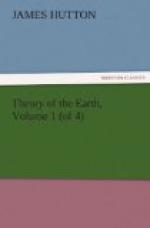In like manner to the north of the Grampians, along the south side of Loch Ness, there are mountains formed of the debris of schistus and granite mountains, first manufactured into sand and gravel, and then consolidated into a pudding-stone, which is always formed upon the same principle. The same is also found upon the south side of those mountains in the shire of Angus.
I may also give for example the African Brechia, which is a pudding-stone of the same nature. This stone is composed of granites or porphyries, serpentines and schisti, extremely indurated and perfectly consolidated. It is also demonstrable from the appearance in this stone that it has been in a softened state, from the shape and application of its constituent parts; and in a specimen of it which I have in my cabinet, there is also a demonstration of calcareous spar flowing among the gravel of the consolidated rock.
This fact therefore of pudding-stone mountains, is a general fact, so far as it is founded upon observations that are made in Africa, Germany, and Britain. We may now reason upon this general fact, in order to see how far it countenances the idea of primitive mountains, on the one hand, or on the other supports the present theory, which admits of nothing primitive in the visible or examinable parts of the earth.
To a person who examines accurately the composition of our mountains, which occupy the south of Scotland, no argument needs be used to persuade him that the bodies in question are not primitive; the thing is evident from inspection, as much as would be the ruins of an ancient city, although there were no record of its history. The visible materials, which compose for the most part the strata of our south alpine schisti, are so distinctly the debris and detritus of a former earth, and so similar in their nature with those which for the most part compose the strata on all hands acknowledged as secondary, that there can remain no question upon that head. The consolidation, again, of those strata, and the erection of them from their original position, and from the place in which they had been formed, is another question.
But the acknowledging strata, which had been formed in the sea of loose materials, to be consolidated and raised into the place of land, is plainly giving up the idea of primitive mountains. The only question, therefore, which remains to be solved, must respect the order of things, in comparing the alpine schisti with the secondary strata; and this indeed forms a curious subject of investigation.




